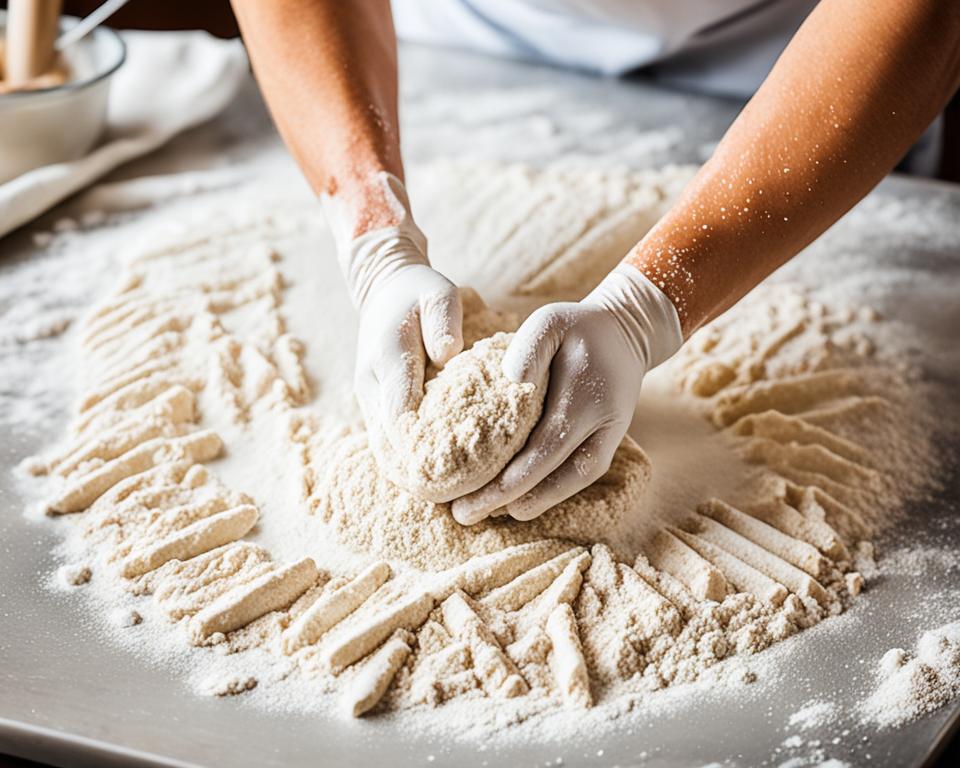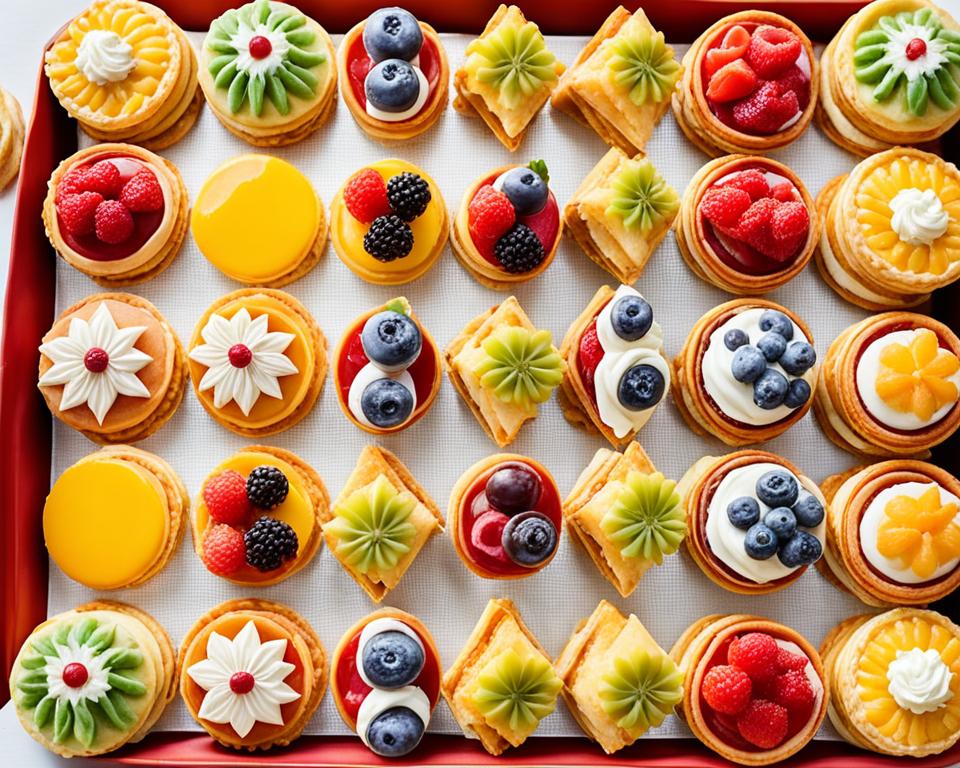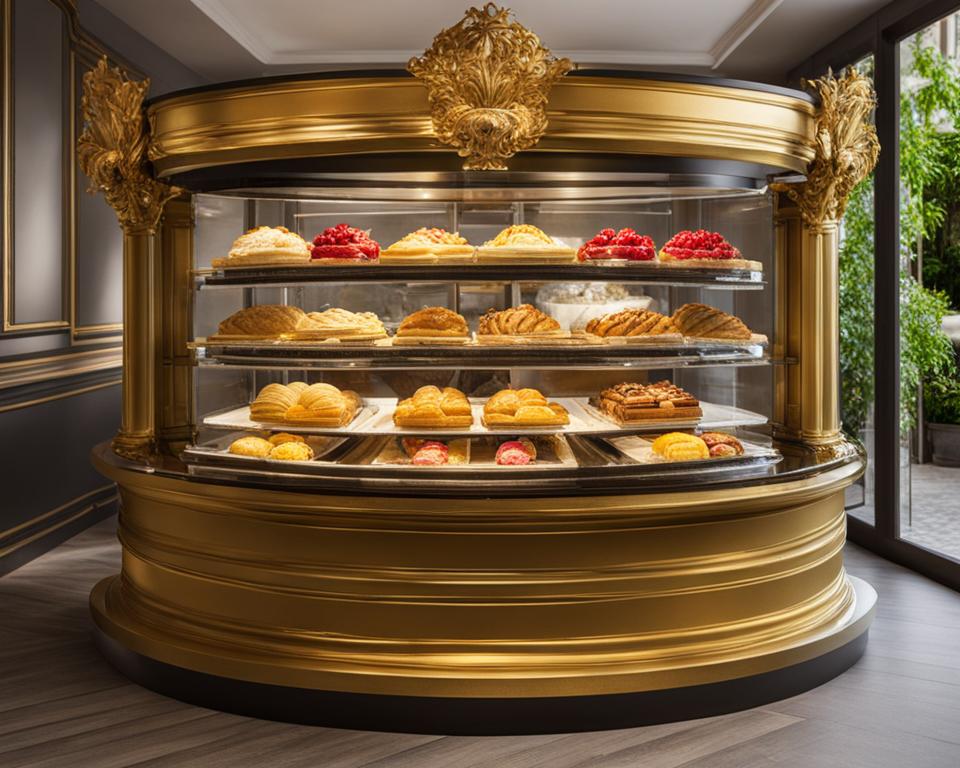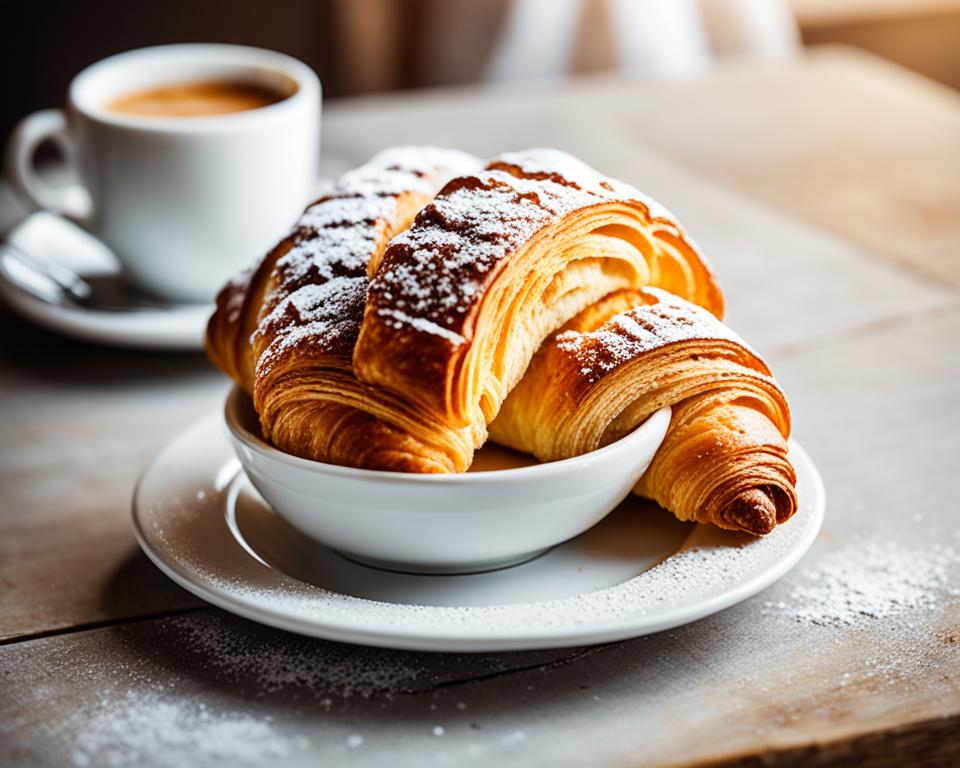Whether you’re a complete beginner or just starting to dabble in the world of baking, having some essential tips and advice can make all the difference. Baking can be a rewarding and enjoyable experience, but it’s important to have the right knowledge and techniques to ensure success. In this beginner’s guide to baking, we’ll share some must-know tips and tricks that will set you on the path to becoming a confident baker.
Key Takeaways:
- Reading the recipe thoroughly is essential for a successful baking experience.
- Prepping your ingredients in advance will make the baking process smoother.
- Accurate measurements are crucial for consistent results.
- Avoid making ingredient substitutions as a beginner.
- Investing in an oven thermometer will ensure accurate baking temperatures.
Read the Recipe Thoroughly
Before embarking on your baking adventure, it’s essential to read the recipe thoroughly. Taking the time to understand the recipe’s instructions and requirements will set you up for success in the kitchen. By following this crucial baking tip, you can avoid mistakes and ensure your baked goods turn out delicious every time.
Here are a few key reasons why reading the recipe thoroughly is so important:
- Prepping Ingredients: Many recipes require specific ingredient preparations, such as chopping, grating, or marinating. By reading the recipe beforehand, you can identify these steps and be prepared ahead of time. This allows for a smoother and more efficient baking process.
- Special Instructions: Some recipes may have unique instructions that need to be followed precisely. For example, the dough may need to be chilled before baking, or certain ingredients may need to be added at specific intervals. By familiarizing yourself with these special instructions, you can ensure you’re following the recipe accurately.
- Required Ingredients and Equipment: Reading the recipe thoroughly allows you to check if you have all the necessary ingredients and equipment before you begin. This will save you from any last-minute surprises or disruptions during the baking process.
- Time Management: Understanding the recipe’s estimated time of preparation and baking is essential for planning. By knowing how long the recipe will take, you can allocate your time accordingly and avoid any unnecessary rush or delays.
Whether you’re baking a simple cake or trying a more complex pastry, taking the time to read the recipe thoroughly will give you the confidence and knowledge you need to achieve baking success.
“Reading the recipe thoroughly before starting not only helps you understand the process, but also allows you to gather all the necessary ingredients and equipment. This ensures a smooth and enjoyable baking experience.” – Jane Smith, Professional Baker
| Benefits of Reading the Recipe Thoroughly |
|---|
| Prepares you for ingredient prepping |
| Helps you follow special instructions accurately |
| Allows you to gather all required ingredients and equipment |
| Aids in effective time management |
Prep Your Ingredients
The French phrase “mise en place” means to put everything in place, and it’s an essential principle in baking. When it comes to baking tips for beginners, one of the most important aspects is prepping your ingredients before you start. By doing so, you’ll ensure a smoother baking process and have everything you need at your fingertips.
Gather all the necessary ingredients according to the recipe. Measure them accurately, and have them ready in separate bowls or containers. This not only helps you stay organized but also ensures that you won’t miss any essential components as you go along.
Preparing your equipment is equally crucial. Check if you have all the utensils and tools needed for the recipe, such as mixing bowls, measuring cups, spoons, whisks, and baking pans. Lay them out on your counter or workspace, making sure you have enough room to comfortably maneuver during the baking process.
Create a Mise en Place Checklist
To make the prepping process easier, you can create a checklist for your “mise en place.” This checklist can include all the ingredients, along with their respective quantities, as well as the necessary equipment. As you gather and measure each item, check them off the list. Not only does this ensure that you won’t forget anything, but it also adds a sense of satisfaction as you see your preparation progress.
Remember, being well-prepared and having everything ready in advance will save you time and minimize the chances of making mistakes or missing vital steps. Now that you’ve prepped your ingredients, it’s time to dive into the baking process!
Measure Ingredients Accurately
Accurate measurements are crucial when it comes to baking. Precise ingredient quantities can make a significant difference in the final outcome of your baked goods. Here are some essential tips to ensure you measure ingredients accurately:
Invest in a Digital Kitchen Scale for Precise Measurements
When it comes to measuring ingredients by weight, a digital kitchen scale is a game-changer for accuracy. It allows you to measure ingredients exactly as specified in the recipe, eliminating any guesswork or variations caused by using measuring cups. This is particularly important for ingredients like flour, where the weight can differ depending on how it’s packed.
For Dry Ingredients, Spoon Lightly and Level Off Excess
When measuring dry ingredients like flour, sugar, or cocoa powder, use a spoon to lightly fill the measuring cup. Avoid packing the ingredients down, as this can lead to an inaccurate measurement. Once the cup is full, level off the excess using a straight-edge utensil, such as a knife or spatula. This technique ensures consistent measurements and prevents any excess ingredients from throwing off the balance of your recipe.
Firmly Pack Brown Sugar
When measuring brown sugar, firmly pack it into the measuring cup. The moisture content in brown sugar can make it prone to clumping, so packing it ensures an accurate measurement. Use the back of a spoon or your fingers to press the sugar into the cup until there are no gaps or air pockets.
Use Separate Measuring Cups for Dry and Liquid Ingredients
Using separate measuring cups for dry and liquid ingredients helps avoid cross-contamination and ensures accurate measurements. Dry ingredient measuring cups are typically designed to be leveled off, while liquid measuring cups have a pouring spout to allow for easy pouring without spilling.
Measure Liquids at Eye Level
When measuring liquids, such as milk or water, always use a liquid measuring cup and measure at eye level. Place the measuring cup on a flat surface and bend down to bring your eyes level with the markings on the cup. This helps ensure accurate measurements, as looking from an angle can lead to incorrect readings.
A Set of Measuring Spoons for Small Ingredient Measurements
In addition to measuring cups, a set of measuring spoons is essential for small ingredient measurements, such as spices or baking powder. These spoons come in different sizes, allowing you to accurately measure small quantities and add just the right amount of flavor or leavening agents to your recipes.
Accurate measurements lay the foundation for successful baking. Investing in the right tools, such as a digital kitchen scale and measuring cups, and following proper techniques ensure that you achieve consistent results every time you bake. By measuring your ingredients accurately, you’ll be one step closer to creating delicious and perfectly baked treats.
Don’t Make Substitutions
When it comes to baking, beginners should resist the temptation to make ingredient substitutions. While experienced bakers may have the knowledge to experiment with different ingredients and quantities, it’s important for beginners to stick to the recipe as much as possible. By following the recipe closely, you can ensure successful results and avoid any potential baking mishaps.
Ingredient substitutions can significantly impact the texture, taste, and overall outcome of your baked goods. Each ingredient serves a specific purpose in a recipe, whether it provides structure, moisture, flavor, or leavening. Making substitutions without a solid understanding of how each ingredient functions can lead to disappointing results.
“Substitutions are best left to experienced bakers who understand the science behind ingredients and how they interact with each other in a recipe.”
As a beginner, it’s essential to familiarize yourself with the ingredients commonly used in baking and their respective roles. This understanding will help you appreciate the importance of following the recipe accurately and enable you to recognize ingredient substitutions that may work well in the future.
Instead of making substitutions, focus on honing your baking skills and building a strong foundation. As you gain more experience and knowledge, you’ll feel more confident in making informed ingredient substitutions that enhance your recipes.
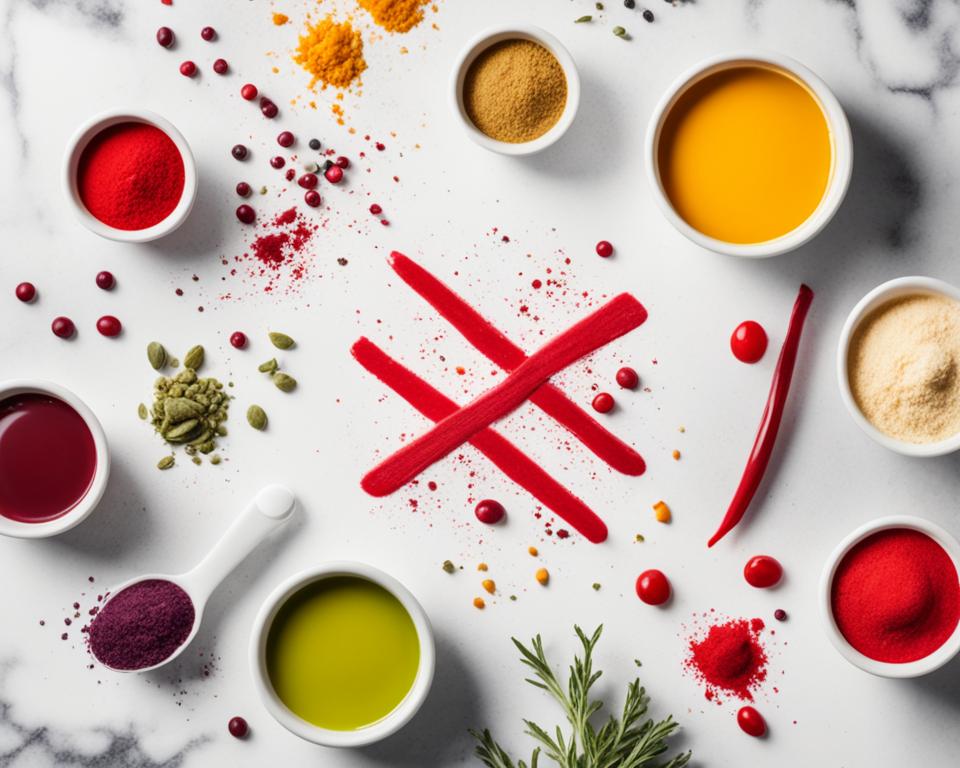
Remember, baking is both an art and a science, and precision plays a crucial role in achieving delicious results. By sticking to the recipe and avoiding ingredient substitutions as a beginner, you’ll increase your chances of baking success and gain a better understanding of the ingredients and techniques involved.
Get an Oven Thermometer
Oven temperature accuracy is vital in baking. Placing an oven thermometer in your oven will help you ensure that the temperature is correct. If your oven temperature is off, you can adjust it or have it calibrated by a professional. This will ensure that your baked goods bake evenly and have the proper texture.
Having an oven thermometer is like having a baking superpower. It allows you to have complete control over your oven’s temperature and ensures that your cakes, cookies, and other treats turn out perfectly every time.
Why is oven temperature so important? Well, baking is a precise science, and the temperature plays a crucial role in how your baked goods rise, cook, and develop their flavors. Too hot, and your cookies will spread into one giant blob; too cold, and your cake will come out dense and undercooked.
Unfortunately, many ovens are not accurate, and the dial or digital display can be misleading. That’s where an oven thermometer comes in. By placing it inside your oven, next to your baking pans, you can accurately gauge the temperature and make any necessary adjustments.
But how do you know if your oven thermometer is accurate? Well, you can do a simple test. Preheat your oven to a specific temperature, such as 350°F (177°C), and check the reading on your oven thermometer. If they match, great! Your oven is calibrated correctly. However, if there’s a discrepancy, you’ll need to adjust your oven’s temperature accordingly.
Don’t worry; adjusting your oven is not as complicated as it sounds. Most ovens have a calibration dial or feature that allows you to make small adjustments to the temperature settings. If you’re not sure how to do this, consult your oven’s manual or contact a professional appliance technician for assistance.
Investing in an oven thermometer is one of the best decisions you can make as a beginner baker. It will give you the confidence to bake with precision and achieve consistent results. So, before you start your next baking project, make sure you have an oven thermometer on hand.
Choose the Right Pans
The choice of baking pans can greatly affect the outcome of your baked goods. When it comes to selecting the right pans, consider using high-quality options that are sturdy and durable. The size of the pan is also crucial for baking success, so it’s important to stick to the recommended size mentioned in the recipe. Changing the size of the pan can impact the baking time and texture of your treats. To ensure even baking and browning, it is generally recommended to use light-colored, metal baking pans.
Using the right pans can make a significant difference in the quality of your baked goods. It ensures that they are evenly baked and have the desired texture. By investing in high-quality pans that match the size specified in the recipe, you set yourself up for success in the kitchen.
If you’re unsure about which pans to choose or need to replace your existing ones, consider these beginner-friendly options:
- Non-stick metal pans: These pans are popular due to their easy food release and clean-up. They are typically made of aluminum or steel with a non-stick coating, preventing your baked goods from sticking to the pan.
- Glass baking dishes: Glass pans offer the advantage of even heat distribution, which helps in achieving consistent baking results. They are great for dishes like casseroles and puddings.
- Silicone molds: Silicone baking molds are flexible and non-stick, making them ideal for delicate pastries like muffins and cupcakes. They also come in various fun shapes and sizes.
Experiment with different types of pans to find what works best for you and your favorite recipes. Remember to always follow the recipe’s instructions regarding the type and size of the pan for optimal results.
| Advantages | Considerations |
|---|---|
| Even baking and browning | Proper pan size is crucial for baking time and texture |
| Sturdy and durable | Light-colored metal pans are generally recommended |
| Easy food release and clean-up | Glass pans offer even heat distribution |
| Flexible and non-stick | Silicone molds are ideal for delicate pastries |
Choose your baking pans wisely and enjoy the process of creating delicious treats with confidence!
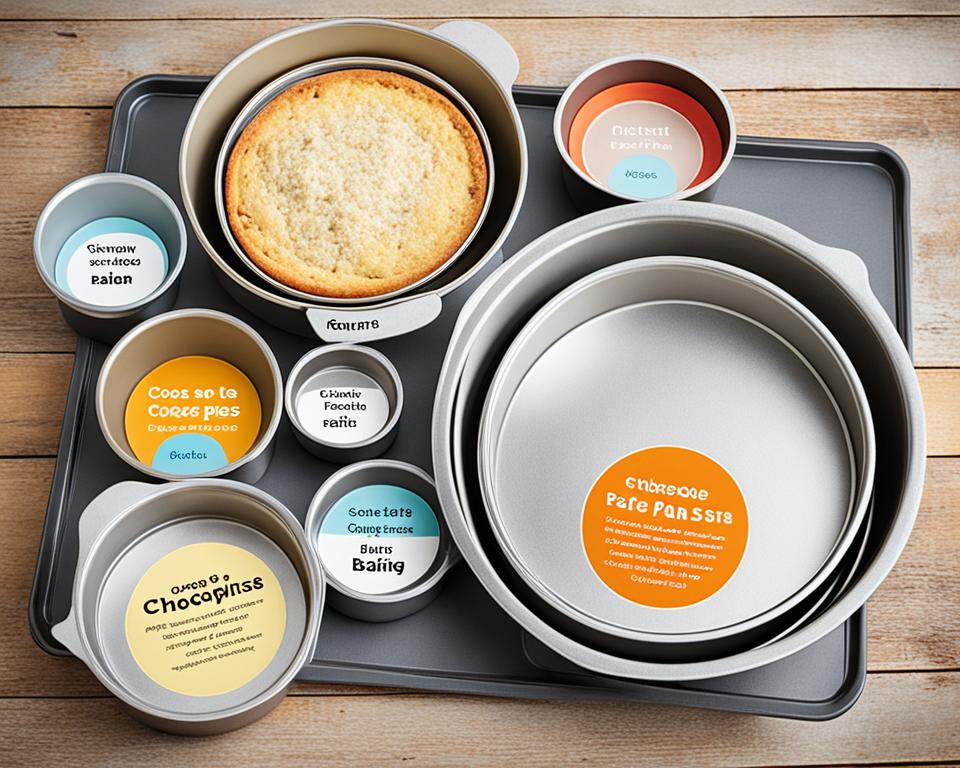
Don’t Over-Mix
When it comes to baking, mixing techniques play a crucial role in achieving the perfect texture and flavor in your baked goods. However, it’s important to know when to stop mixing to avoid detrimental effects on the final result.
Over-mixing, especially for doughs that develop gluten, can lead to tough and dense baked goods. To ensure light and tender treats, follow these essential baking tips:
- Mix doughs and batters just until they are combined. Use a gentle hand and avoid excessive stirring or beating.
- Follow the specific recipe’s instructions regarding mixing time. Different recipes may have varying requirements for mixing.
By adhering to these guidelines, you’ll be able to maintain the integrity of your baked goods and achieve the desired outcome. Remember, less is often more when it comes to mixing!
“Mixing the ingredients just until combined is the key to achieving light and tender baked goods. Over-mixing can lead to a less-than-desirable texture.”
| Baking Tips | Mixing Techniques | Result |
|---|---|---|
| Follow recipe instructions | Gently combine ingredients | Light and tender baked goods |
| Avoid excessive stirring | Stop mixing when just combined | Avoid tough and dense texture |
| Be mindful of mixing time | Check recipe for specific guidelines | Consistent results |
Don’t Open the Oven Door
When it comes to baking, it’s important to resist the temptation to constantly peek into the oven. Opening the oven door unnecessarily can cause temperature fluctuations, which can have a negative impact on your baking. These fluctuations can result in uneven baking, longer baking times, and even a compromised texture in your final products. So, it’s best to keep the oven door closed during the majority of the baking process.
If you need to check for doneness, such as when testing a cake with a toothpick or checking the color and browning of cookies, try to do so quickly without fully opening the door. Peeking through the oven window can usually give you a good idea of how your baked goods are progressing.
By minimizing the number of times you open the oven door, you can maintain a consistent temperature and ensure that your baking is not compromised. Follow this essential baking advice to achieve consistent and delicious results.
Know How to Check for Doneness
Knowing when your baked goods are done is essential for achieving perfect results. Follow the recipe’s instructions for doneness checks, which may include visual cues like browning or setting.
A common method to determine doneness is by using a toothpick or cake tester. Insert it into the center of the baked goods and then remove it. If it comes out clean or with a few moist crumbs, your baked goods are ready. If the toothpick has raw batter or excessive crumbs, the baking time needs to be extended.
Each recipe may have specific visual or tactile cues for doneness. For example, a cake might spring back when touched lightly, or cookies might have a golden brown color around the edges. Pay attention to these cues, as they indicate that your baked goods have reached the desired level of doneness.
Doneness Chart
| Baked Goods | Doneness Cues |
|---|---|
| Cakes | Springy texture when touched lightly, toothpick comes out clean or with a few moist crumbs |
| Cookies | Golden brown color around the edges |
| Breads and Loaves | Golden brown crust, hollow sound when tapped on the bottom |
| Pies | Firm, golden brown crust, filling set in the center |
Conclusion
By implementing these essential baking tips for beginners, you’ll gain the necessary skills and knowledge to confidently embark on your baking journey. Whether you’re reading the recipe thoroughly, prepping your ingredients, or choosing the right pans, these beginner-friendly baking tips will set you up for success.
Remember, baking is not just about following a recipe; it’s about the joy of creating something delicious. Embrace the process, practice, and don’t be afraid to experiment with flavors and techniques. Every bake is a learning opportunity to master the basics and develop your own unique style.
So, grab your apron, gather your ingredients, and let your creativity flow in the kitchen. With these essential tips and a dash of passion, you’ll be well on your way to becoming a confident and skilled baker. Happy baking!
FAQ
What should I do before I start baking?
It’s crucial to read the recipe thoroughly and take note of any special instructions, assess the required ingredients, equipment, and time needed for the recipe.
Why is it important to prep ingredients?
Prepping ingredients ensures that you have everything you need before you start baking, making the baking process easier and more organized.
How should I measure ingredients accurately?
Invest in a digital kitchen scale for precise measurements by weight, spoon dry ingredients lightly into measuring cups and level off the excess, firmly pack brown sugar, use separate measuring cups for dry and liquid ingredients, and measure liquids at eye level.
Can I make substitutions in baking recipes?
It’s best for beginners to stick to the recipe as much as possible until they have a better understanding of how ingredients work together. Avoid making substitutions until you’re more experienced.
Why do I need an oven thermometer?
An oven thermometer ensures that your oven temperature is accurate, which is essential for even baking and proper texture in your baked goods.
How do I choose the right baking pans?
Use high-quality, sturdy, and durable pans that are recommended in the recipe. Stick to the recommended pan size, as changing the size can impact baking time and texture.
Why is it important not to over-mix?
Over-mixing can result in tough baked goods, so it’s important to mix doughs and batters just until they are combined as per the specific recipe’s instructions.
Why should I avoid opening the oven door unnecessarily?
Opening the oven door unnecessarily can cause temperature fluctuations, which can affect baking time and texture. Only open the oven door when necessary, such as for a doneness check.
How can I check if my baked goods are done?
Follow the recipe’s instructions for doneness checks, such as checking for browning or setting. You can also use a toothpick or cake tester to check if the center comes out clean or with a few crumbs.

